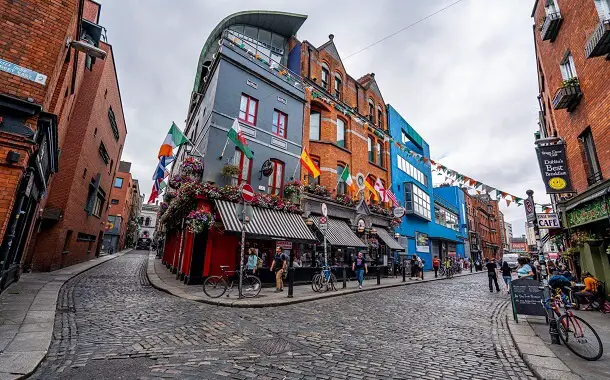How Much Does it Cost to Travel to Ireland?
Last Updated on March 5, 2024
Written by CPA Alec Pow | Content Reviewed by ![]() CFA Alexander Popinker
CFA Alexander Popinker
With its vibrant culture, magical landscapes, and friendly locals, Ireland is a dream destination for many travelers. But how much does an Irish vacation truly cost?
This comprehensive guide breaks down typical costs and provides money-saving tips to keep your trip affordable.
Highlights
- Total daily costs range widely from $100 to $500+ depending on lodging, activities, and dining choices.
- Flights and ground transport account for a big chunk of trip expenses.
- Aim to visit during the shoulder season for lower rates on airfare, hotels, and car rentals.
- Balance splurges on nice dinners out with affordable breakfasts, picnics, and pub meals.
- Take advantage of abundant free natural and cultural activities.
How Much Does it Cost to Travel to Ireland?
Traveling in Ireland can range from $100-$200 per day for budget backpackers to $500+ daily for luxury travelers wanting upscale hotels, fine dining, and VIP sights. The average Ireland trip with mid-range choices costs $150-$300 per day.
According to We3Travel, a nine-night trip to Ireland for a family of four in the summer costs around $9,140 or $254 per day, including expenses like airfare, accommodations, transportation, tours & activities, and food.
The World Was Here First writes that the average trip cost to Ireland, excluding flights, ranges from €90 to €175 per person per day, covering expenses like food, accommodation, transport, activities, and entertainment.
The Irish Road Trip notes that based on a 5-day trip for two people flying from the USA in June, the average trip cost to Ireland ranges from €2,523/$2,679 for a budget trip to €6,641/$7,051 for a luxury trip.
Trip.com has an article saying that for a three-day and two-night trip for two people, the total cost to Ireland is approximately US$1,500 per person. Additionally, the cost of travel insurance can range from US$80 for a 10-day trip to US$169 for a 364-day trip.
Budget Your Trip mentions that visitors should plan to spend around $149 (€137) per day on their vacation in Ireland based on the expenses of other travelers.
Major expenses include airfare, ground transport, lodging, food, activities, and shopping. Visiting during the shoulder season and taking advantage of deals allows you to stretch your budget much further.
Average Daily Ireland Trip Budgets
- Backpacker/Budget: $80-150 for hostels, markets, free sites
- Mid-range: $150-250 for B&Bs, day tours, pub meals
- Luxury: $350-$500+ for 5-star hotels, fine dining, VIP tours
Withdraw cash from ATMs as needed in Euros. Have at least $100 emergency cash on hand as a buffer.
Transportation
Airfare is often the single biggest upfront cost for Ireland trips. Direct round-trip flights from the US East Coast to Dublin average $500-$800 depending on season and airline.
Connecting flights from other US cities can be $100-$300 cheaper but add travel time. Look for deals on Aer Lingus and budget carriers like Ryanair, especially in shoulder seasons like April. Avoid booking during peak summer months if possible.
Once in the country, public transportation like trains and buses between cities is inexpensive, generally costing $5-$30 per trip depending on distance. Rural buses may be cheaper.
Renting a car provides maximum flexibility for road-tripping to small towns and remote sights, starting around $40 per day but more like $60+ in high season. Reserve rental cars well in advance for the best deals. If sticking to just Dublin, public transit and taxis suffice.
Intercity trains like Irish Rail are faster than buses with similar fares. Check for discounted rail passes if traveling extensively. The slower rural trains offer scenic sightseeing value.
Lodging
Hostels offer the most budget-friendly accommodations in Ireland, with dorm beds ranging from $20-40 per night and private rooms going for $60 and up. They provide a ready source of traveler tips and opportunities to socialize. Amenities are basic.
You might also like our articles about the cost of traveling to The Bahamas, The Dominican Republic, or Norway.
Mid-range options like 3-star hotels and local B&Bs provide more comfort and hospitality, ranging from $80-$150 per night for double rooms including breakfast. B&Bs give you insights into Irish culture through your hosts. Brands like Travelodge offer reliable budget hotel rooms for around $100/night.
On the luxury end, tabs can run $300+ nightly for 5-star hotels and castle stays. For longer visits, renting a cottage or apartment through platforms like Airbnb can be cost-effective, often $100-250 per night. Vacation home rentals let you cook meals and feel at home. Shoulder season rates offer around 20% savings.
Dining
Eating out 3 times a day gets pricy fast, so grocery shopping at Tesco and cooking basic meals helps stretch your budget. Expect to spend $30-$50 per day on groceries if you prepare most meals yourself.
Sit-down lunches and pub meals generally cost $10-$20 per person. Dinner at nice restaurants with drinks will run at least $25-$40 per person.
Indulge in local specialties like seafood chowder, Irish stew, soda bread, black and white pudding, and of course, Guinness without blowing your budget. Hit up public markets for deals on baked goods, cheeses, chocolates, and interesting finds. Staying at B&Bs includes breakfast.
Free Attractions and Entry Fees
One great way to save is by visiting the abundance of free attractions Ireland offers – no tickets required! Temple Bar, Phoenix Park, seaside cliffs, and rolling countryside are ready to explore. Historic churches and cathedrals are mostly free to enter.
Museums typically cost $10-20 per person for admission. Famous sights like the Guinness Storehouse run $20-$30. Regular ticket prices to attractions like the Cliffs of Moher are $8-15.
Consider getting the Dublin Pass for over 55 included attractions and discounts – it can pay for itself quickly if you pack in the activities. Passes cost $60-$100 depending on duration. Pre-booking flexible tickets online secures the lowest rates.
Activities
Taking advantage of Ireland’s natural beauty is easy on any budget. Hiking through stunning national parks and coastal trails is free. Renting bikes or gear starts around $15 per day.
Guided day tours by bus or van allow you to see the most ground efficiently, starting at $40 per person and up. Keep evenings affordable by unwinding in cozy pubs listening to free live music sessions.
Outdoor concerts, festivals, and street performances also offer affordable entertainment. Consider splurging on a once-in-a-lifetime experience like Gaelic sports or surfing lessons.
Markets, Woolens, and Souvenirs
 Shopping is tempting given Ireland’s abundance of woolens, crystal, cutlery, craft beverages, beauty products, and other well-made local goods. Get your retail fix hunting for deals at open-air flea markets and shops carrying Irish brands. For unique ceramics, jewelry, art, and clothing, expect to spend $20-$100 per special piece.
Shopping is tempting given Ireland’s abundance of woolens, crystal, cutlery, craft beverages, beauty products, and other well-made local goods. Get your retail fix hunting for deals at open-air flea markets and shops carrying Irish brands. For unique ceramics, jewelry, art, and clothing, expect to spend $20-$100 per special piece.
Quality Irish woolens like sweaters and scarves make wonderful gifts and mementos. They average $50-$200+. Limit souvenir spending to $10-$30 per day and leave space in your bag to bring treasures home.
Saving Money While Traveling in Ireland
The good news is there are many ways to save on your Ireland adventure:
- Visit during shoulder season months like April-May and September-October for lower rates on accommodation and airfare.
- Take advantage of tourist discount passes and pre-book tickets to major attractions whenever possible.
- Rent a car for longer trips but use public transport within big cities to avoid parking fees.
- Choose smaller towns and rural areas over just crowded, expensive Dublin.
- Skip drinking at high-end bars and club. Pre-game at your hotel.
- Get groceries at Tesco instead of eating all meals out.
Additional Ireland Travel Costs
Budget for these other common Ireland trip expenses:
- Travel insurance: $30-$100 for 1-2 week trip
- Prepaid SIM card: $30-$50 for moderate data use
- Bank fees: Up to 3% on credit/debit swipes and ATM withdrawals
- Visa: $0 for US citizens; $100+ for other nationalities
- Vaccines: $0-$150 for recommended immunizations
Final Words
With proper budgeting and some tactical saving strategies, you can craft an amazing, authentic Ireland adventure no matter your travel style or budget! The emerald magic of Eire awaits.
Frequently Asked Questions
Is Ireland expensive to visit compared to other European destinations?
Yes, Ireland is pricier than popular budget destinations like Spain, Greece, Portugal, or Eastern Europe. However, it doesn’t have to break the bank.
Avoiding peak summer travel, using public transport, cooking rather than dining out daily, limiting shopping, and taking advantage of free attractions all make visiting Ireland more affordable. Overall costs average $100-$200 per day.
Can I use US dollars in Ireland?
No, US dollars are generally not accepted directly in Ireland. As part of the Eurozone, businesses deal strictly in Euro banknotes and coins.
Withdraw cash once you arrive as needed from ATMs using your debit card. Inform your bank of your travel dates to prevent foreign transaction holds on your account back home due to “suspicious” overseas charges.
What is the best time of year to visit Ireland for lower costs?
The ideal months for pleasant weather, lighter crowds, and lower costs in Ireland are April, May, September and October. Summertime draws peak tourist crowds along with jacked up hotel, tour, and activity prices.
Winter offers some holiday charm but cooler weather. Aim to travel in the shoulder seasons for savings up to 30% on flights, lodging, and attractions compared to visiting in July-August.


Leave a Reply
Want to join the discussion?Feel free to contribute!